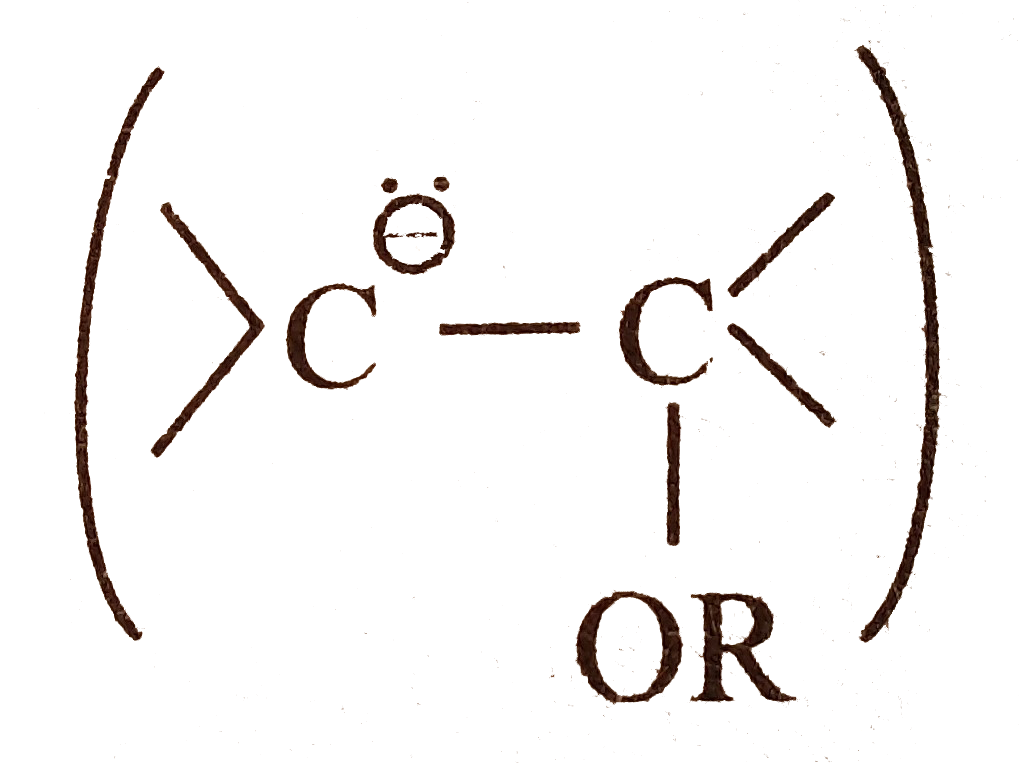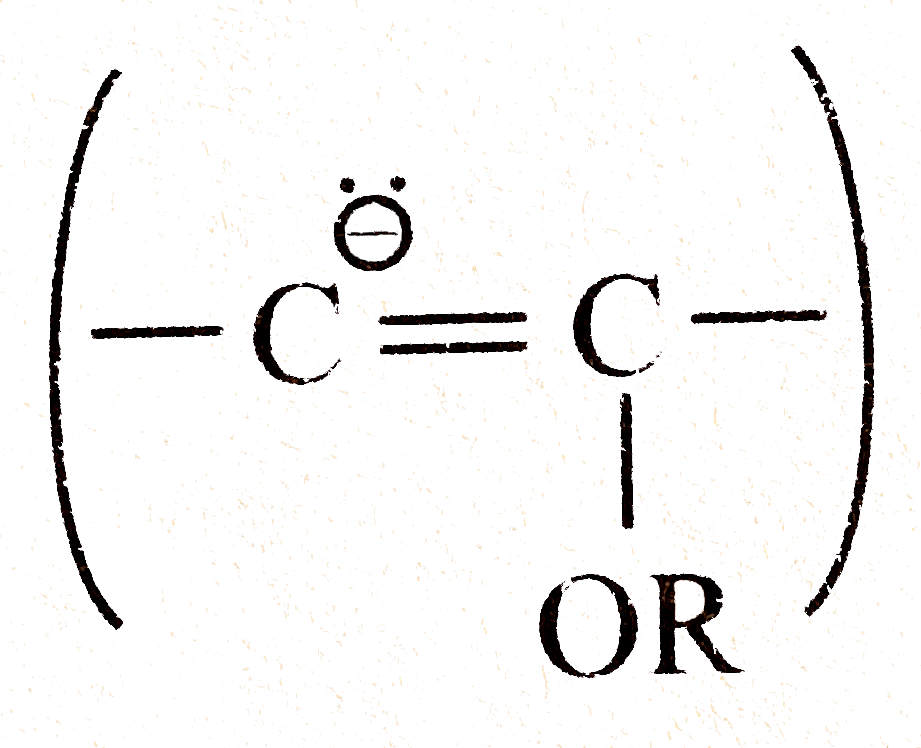Which of the statements are WRONG about the nucleophilic addition reaction of alkenes and alkynes?
Addition of nucleophile (RӨO) to alkene gives an alkyl carbanion  whose negative charge is on the sp3-hydridised C atom.
whose negative charge is on the sp3-hydridised C atom.
Addition of nucleophile (RӨO) ot an alkyne gives a vinyl carbanion  whose negative charge is on the sp2-hybridised C atom. Due to more s character, it is readily formed and more stable than alkyl carbanion formed with alkenes. So alkynes are more reactive than alkenes towards NA reaction.
whose negative charge is on the sp2-hybridised C atom. Due to more s character, it is readily formed and more stable than alkyl carbanion formed with alkenes. So alkynes are more reactive than alkenes towards NA reaction.
Strong electron-withdrawing inductive effect (−I) further stabilises both vinyl and alkyl carbanion.
Strong electron-donating inductive effect (+I) further stabilises both vinyl and alkyl carbanion.
The correct Answer is:D
To determine which statements are wrong about the nucleophilic addition reaction of alkenes and alkynes, we will analyze the properties and behavior of these compounds during the reaction.
1. Understanding Nucleophilic Addition:
- Nucleophilic addition involves the attack of a nucleophile (like RO⁻) on a carbon atom of a double or triple bond (alkene or alkyne).
- The reaction leads to the formation of a carbon ion intermediate.
Hint: Remember that nucleophiles are electron-rich species that seek positive centers.
2. Formation of Carbon Ions:
- In the case of an alkene, the nucleophile attacks an sp³ hybridized carbon atom, resulting in a carbon ion with a negative charge on the sp³ carbon.
- In the case of an alkyne, the nucleophile attacks an sp² hybridized carbon atom, leading to a carbon ion with a negative charge on the sp² carbon.
Hint: Identify the hybridization of the carbon atom involved in the reaction to understand the stability of the resulting carbon ion.
3. Stability of Carbon Ions:
- The carbon ion formed from an alkyne (vinyl carbon ion) is more stable than that formed from an alkene (alkyl carbon ion) because sp² hybridized carbons have more s-character, making them more electronegative and stabilizing the negative charge.
Hint: Recall that the greater the s-character, the more stable the carbon ion due to increased electronegativity.
4. Reactivity Comparison:
- Alkynes are more reactive than alkenes in nucleophilic addition reactions due to the stability of the carbon ion formed from alkynes.
- Conversely, in electrophilic addition reactions, alkenes are more reactive than alkynes.
Hint: Differentiate between nucleophilic and electrophilic addition reactions when considering reactivity.
5. Effect of Inductive Effects:
- A strong electron-withdrawing group (−I effect) stabilizes the carbon ion by decreasing charge density, while a strong electron-donating group (+I effect) destabilizes it by increasing charge density.
Hint: Remember that the nature of substituents on the carbon chain can significantly influence the stability of intermediates.
6. Analyzing Statements:
- Statement A: "Addition of a nucleophile to an alkene gives an alkyl carbon ion whose negative charge is on the sp³ hybridized C atom." - This is correct.
- Statement B: "Addition of a nucleophile on the alkyne gives the vinyl carbon ion whose negative charge is on the sp² hybridized carbon atom due to more s-character it is readily formed and hence is more stable than alkyl carbon ion formed with the alkenes." - This is correct.
- Statement C: "Alkynes are more reactive than alkenes towards nucleophilic addition reactions." - This is correct.
- Statement D: "Strong electron donating inductive effect further stabilizes both vinyl and alkyl carbon." - This is wrong; strong electron donating groups destabilize the carbon ions.
Conclusion:
The wrong statement about the nucleophilic addition reaction of alkenes and alkynes is Statement D.
- Nucleophilic addition involves the attack of a nucleophile (like RO⁻) on a carbon atom of a double or triple bond (alkene or alkyne).
- The reaction leads to the formation of a carbon ion intermediate.
- In the case of an alkene, the nucleophile attacks an sp³ hybridized carbon atom, resulting in a carbon ion with a negative charge on the sp³ carbon.
- In the case of an alkyne, the nucleophile attacks an sp² hybridized carbon atom, leading to a carbon ion with a negative charge on the sp² carbon.
- The carbon ion formed from an alkyne (vinyl carbon ion) is more stable than that formed from an alkene (alkyl carbon ion) because sp² hybridized carbons have more s-character, making them more electronegative and stabilizing the negative charge.
- Alkynes are more reactive than alkenes in nucleophilic addition reactions due to the stability of the carbon ion formed from alkynes.
- Conversely, in electrophilic addition reactions, alkenes are more reactive than alkynes.
- A strong electron-withdrawing group (−I effect) stabilizes the carbon ion by decreasing charge density, while a strong electron-donating group (+I effect) destabilizes it by increasing charge density.
- Statement A: "Addition of a nucleophile to an alkene gives an alkyl carbon ion whose negative charge is on the sp³ hybridized C atom." - This is correct.
- Statement B: "Addition of a nucleophile on the alkyne gives the vinyl carbon ion whose negative charge is on the sp² hybridized carbon atom due to more s-character it is readily formed and hence is more stable than alkyl carbon ion formed with the alkenes." - This is correct.
- Statement C: "Alkynes are more reactive than alkenes towards nucleophilic addition reactions." - This is correct.
- Statement D: "Strong electron donating inductive effect further stabilizes both vinyl and alkyl carbon." - This is wrong; strong electron donating groups destabilize the carbon ions.
The wrong statement about the nucleophilic addition reaction of alkenes and alkynes is Statement D.
Topper's Solved these Questions
- BOOK - CENGAGE CHEMISTRY ENGLISHCHAPTER - ALKYNESEXERCISE - Exercises (Single Correct Answers Type)30videos
ALKYNES
- BOOK - CENGAGE CHEMISTRY ENGLISHCHAPTER - ALKYNESEXERCISE - Exercises (Archives - Single Correct Answer Type)6videos
ALKYNES
- BOOK - CENGAGE CHEMISTRY ENGLISHCHAPTER - ALKYNESEXERCISE - Exercises (Linked Comprehension Type)51videos
ALKYNES
- BOOK - CENGAGE CHEMISTRY ENGLISHCHAPTER - ALKENES AND ALKADIENESEXERCISE - Single correct Answer14videos
ALKENES AND ALKADIENES
- BOOK - CENGAGE CHEMISTRY ENGLISHCHAPTER - APPENDIX - INORGANIC VOLUME 1EXERCISE - chapter-7 Single correct answer1videos
APPENDIX - INORGANIC VOLUME 1
Similar Questions
Which gives nucleophilic addition reaction?
View SolutionDescribe the oxidation reactions of alkenes and alkynes.
View SolutionGive nucleophilic addition reaction of acetaldehyde with
HCNView SolutionNucleophilic addition reaction will be most favoured in
View SolutionGive nucleophilic addition reaction of acetaldehyde with
Grignard's reagentsView SolutionWhich of the statement about breeding is wrong
View SolutionGive nucleophilic addition reaction of acetaldehyde with
NaHCO3View Solution
Which of the statements are correct about the reactivities of alkene, alkynes, and arenes?View SolutionGive nucleophilic addition reaction of acetaldehyde with
Ethyl alcoholView SolutionWhat type of addition reactions do alkenes usually undergo ?
View Solution

